
An aircraft carrier is a warship that serves as a seagoing airbase, equipped with a full-length flight deck and facilities for carrying, arming, deploying, and recovering aircraft. Typically, it is the capital ship of a fleet, as it allows a naval force to project air power worldwide without depending on local bases for staging aircraft operations. Carriers have evolved since their inception in the early twentieth century from wooden vessels used to deploy balloons to nuclear-powered warships that carry numerous fighters, strike aircraft, helicopters, and other types of aircraft. While heavier aircraft such as fixed-wing gunships and bombers have been launched from aircraft carriers, one has yet to successfully land on one. By its diplomatic and tactical power, its mobility, its autonomy and the variety of its means, the aircraft carrier is often the centerpiece of modern combat fleets. Tactically or even strategically, it replaced the battleship in the role of flagship of a fleet. One of its great advantages is that, by sailing in international waters, it does not interfere with any territorial sovereignty and thus obviates the need for overflight authorizations from third-party countries, reduces the times and transit distances of aircraft and therefore significantly increase the time of availability on the combat zone.

HMS Ocean was a Royal Navy Colossus-class light fleet aircraft carrier of 13,190 tons built in Glasgow by Alexander Stephen & Sons. Her keel was laid in November 1942, and she was commissioned on 30 June 1945.

Mulberry harbours were temporary portable harbours developed by the United Kingdom during the Second World War to facilitate the rapid offloading of cargo onto beaches during the Allied invasion of Normandy in June 1944. After the Allies successfully held beachheads following D-Day, two prefabricated harbours were taken in sections across the English Channel from the UK with the invading army and assembled off Omaha Beach and Gold Beach.
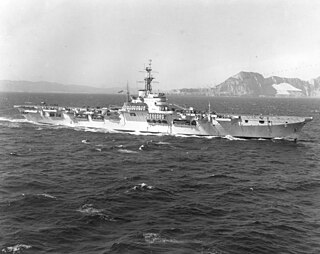
HMS Warrior was a Colossus-class light aircraft carrier which was ordered in 1942 by the British Royal Navy during World War II. Construction was finished in 1945 and upon completion, the aircraft carrier was loaned to the Royal Canadian Navy from 1946 to 1948 as HMCS Warrior. Warrior was returned to the Royal Navy in 1948 and entered service with the British. While in service with the Royal Navy, Warrior was modernised twice, including the installation of an angled flight deck in 1956. In 1948–1949, the ship was used in aircraft landing experiments and fitted with a rubber flight deck and in 1957, was used as the headquarters ship during nuclear testing at Christmas Island. In 1958, the vessel was sold to the Argentine Navy and entered Argentine service in 1959 as ARA Independencia. The aircraft carrier remained in service until 1970 when Independencia was placed in reserve. The following year, the ship was sold for scrap.

Project Habakkuk or Habbakuk was a plan by the British during the Second World War to construct an aircraft carrier out of pykrete for use against German U-boats in the mid-Atlantic, which were beyond the flight range of land-based planes at that time. The idea came from Geoffrey Pyke, who worked for Combined Operations Headquarters. After promising scale tests and the creation of a prototype on Patricia Lake, Jasper National Park, in Alberta, Canada, the project was shelved due to rising costs, added requirements, and the availability of longer-range aircraft and escort carriers which closed the Mid-Atlantic gap that the project was intended to address.

The flight deck of an aircraft carrier is the surface from which its aircraft take off and land, essentially a miniature airfield at sea. On smaller naval ships which do not have aviation as a primary mission, the landing area for helicopters and other VTOL aircraft is also referred to as the flight deck. The official U.S. Navy term for these vessels is "air-capable ships".

HMS Eagle was an Audacious-class aircraft carrier of the Royal Navy, in service 1951–1972. Until the arrival of the Queen Elizabeth-class aircraft carriers in the 21st century, she and her sister Ark Royal were the two largest Royal Navy aircraft carriers ever built.

Landing craft are small and medium seagoing watercraft, such as boats and barges, used to convey a landing force from the sea to the shore during an amphibious assault. The term excludes landing ships, which are larger. Production of landing craft peaked during World War II, with a significant number of different designs produced in large quantities by the United Kingdom and United States.

Arromanches-les-Bains is a commune in the Calvados department in the Normandy region of north-western France.
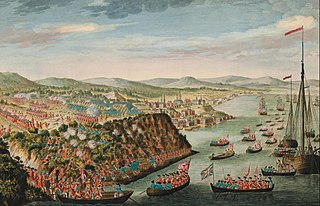
Amphibious warfare is a type of offensive military operation that today uses naval ships to project ground and air power onto a hostile or potentially hostile shore at a designated landing beach. Through history the operations were conducted using ship's boats as the primary method of delivering troops to shore. Since the Gallipoli Campaign, specialised watercraft were increasingly designed for landing troops, material and vehicles, including by landing craft and for insertion of commandos, by fast patrol boats, zodiacs and from mini-submersibles.

A submarine aircraft carrier is a submarine equipped with aircraft for observation or attack missions. These submarines saw their most extensive use during World War II, although their operational significance remained rather small. The most famous of them were the Japanese I-400-class submarines and the French submarine Surcouf, although small numbers of similar craft were built for other nations' navies as well.

HMS Eagle was an early aircraft carrier of the Royal Navy. Ordered by Chile during the South American dreadnought race as the Almirante Latorre-class battleship Almirante Cochrane, she was laid down before World War I. In early 1918 she was purchased by Britain for conversion to an aircraft carrier; this work was finished in 1924. Her completion was delayed by labour troubles and the possibility that she might be repurchased by Chile for reconversion into a battleship, as well as the need for comparative trials to determine the optimum layout for aircraft carriers. The ship was initially assigned to the Mediterranean Fleet and then later to the China Station, spending very little time in home waters other than for periodic refits.
The Malta-class aircraft carrier was a British large aircraft carrier design of World War II. Four ships were ordered in 1943 for the Royal Navy, but changing tactical concepts, based on American experience in the Pacific War, caused repeated changes to the design, which was not completed before the end of the war. All four ships were cancelled in 1945 before they were laid down.
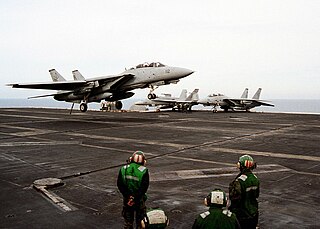
An arresting gear, or arrestor gear, is a mechanical system used to rapidly decelerate an aircraft as it lands. Arresting gear on aircraft carriers is an essential component of naval aviation, and it is most commonly used on CATOBAR and STOBAR aircraft carriers. Similar systems are also found at land-based airfields for expeditionary or emergency use. Typical systems consist of several steel wire ropes laid across the aircraft landing area, designed to be caught by an aircraft's tailhook. During a normal arrestment, the tailhook engages the wire and the aircraft's kinetic energy is transferred to hydraulic damping systems attached below the carrier deck. There are other related systems which use nets to catch aircraft wings or landing gear. These barricade and barrier systems are only used for emergency arrestments for aircraft without operable tailhooks.

Mobile offshore base (MOB), sometimes called a joint mobile offshore base (JMOB), is a concept for supporting military operations beyond the home shores, where conventional land bases are not available, by deploying on the high seas or in coastal waters, in-theater multipurpose floating base assembled from individual platforms. In essence, a MOB is a multipurpose modular self-propelled floating platform, or several interconnected platforms, that can perform multiple functions of a sea base including strike, deployment and logistics. An ocean-wise semi-submersible wave and wind resistant platform capable of moving at one-half the speed of conventional prepositioning monohull cargo ship has been researched and proposed, but never built.
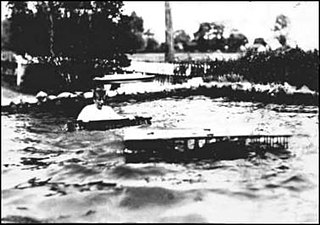
Edward Robert Armstrong (1876–1955) was a Canadian-American engineer and inventor who in 1927 proposed a series of "seadrome" floating airport platforms for airplanes to land on and refuel for transatlantic flights. While his original concept was made obsolete by long-range aircraft that did not need such refueling points, the idea of an anchored deep-sea platform was later applied to use for floating oil rigs.

A floating airport is an airport built and situated on a very large floating structure (VLFS) located many miles out at sea utilizing a flotation type of device or devices such as pneumatic stabilized platform (PSP) technology.

An amphibious assault ship is a type of amphibious warfare ship employed to land and support ground forces on enemy territory by an amphibious assault. The design evolved from aircraft carriers converted for use as helicopter carriers. Modern ships support amphibious landing craft, with most designs including a well deck. Coming full circle, some amphibious assault ships also support V/STOL fixed-wing aircraft, now having a secondary role as aircraft carriers.

An amphibious warfare ship is an amphibious vehicle warship employed to land and support ground forces, such as marines, on enemy territory during an amphibious assault.
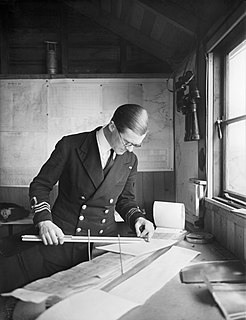
Robert Lochner (1904–1965) was the inventor of The Bombardon Breakwater, an integral part of the Mulberry Harbour, which helped the successful invasion of the Normandy Beaches in June 1944.


















